PDF version [PDF: 235KB]
In the last few years, policy makers in Japan have embarked on an ambitious effort to decisively get the economy out of deflation and revive growth. This policy approach, which has been dubbed "Abenomics" after Prime Minister Shinzo Abe, comprises three so-called "arrows", namely monetary policy, fiscal policy, and growth enhancing structural reforms. In this article, we seek to evaluate the effects of Abenomics' reforms in terms of inclusiveness. Inclusive growth is a multidimensional concept and the notion has varying definitions, interpretations and connotations. To study the degree of inclusiveness of the Japanese economy, we will first review trends in equity, and then refer to econometric studies attempting to assess how implementation of Abenomics is expected to affect inclusive growth.
Income Inequality
When measured using the Gini coefficient of market income (before fiscal redistribution), inequality in Japan increased steadily from 1985 through 2009. While an upward trend and some degree of convergence can be observed amongst all G7 countries, Japan's pace of increasing inequality has been exceptionally high, marking a 15-point increase in about 25 years. The latest available figures for 2009 imply that income inequality in Japan, starting from the lowest G7 level in the mid-1980s, has almost converged to the G7 average of 0.50 (Chart 1).
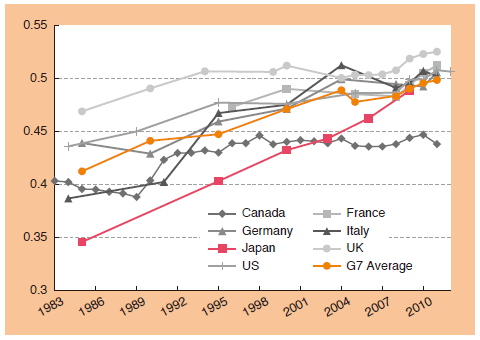
Part of the increase in inequality might be related to the exceptionally rapid pace of aging of the Japanese population. As R. S. Jones suggests in "Income Inequality, Poverty and Social Spending in Japan" (OECD Economic Department Working Papers, No. 556, 2007), an increasing share of elderly population increases income inequality for various reasons: the elderly population earns less income than the working population; inequality among the elderly population is greater than within the working population; and an increasing number of elderly people have been forming small households consisting of elderly only, instead of forming households with working-age population.
Another measure of income inequality, which takes into account the impact of fiscal redistribution, is the Gini coefficient of disposable income. This measure reflects the actual livelihood status of households, as disposable income represents how much each household, including those who retired, is capable to spend after tax and transfers. In Japan, the disposable income Gini coefficient rose moderately, yet consistently (with the exception of a temporary drop in the early 2000s) over the last three decades. Notably, inequality in Japan has been above the G7 average and even its pace of increase has exceeded that of the G7 average in most years (Chart 2). The latest figure for 2009 is about 0.33, slightly above the G7 average.
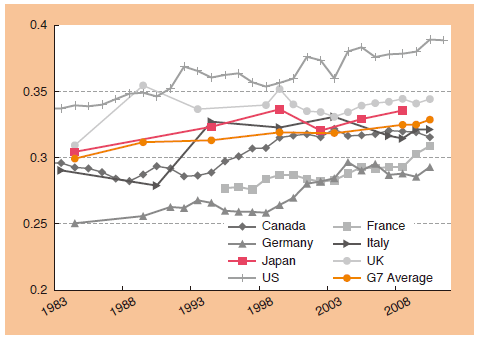
Looking at both market and disposable income Gini, and further disaggregating these measures between working-age and elderly populations, gives important insights into various aspects of inequality. First, fiscal redistribution is effective in reducing inequality for both the elderly and the working-age population, as seen in the gaps between the respective market and disposable income Gini coefficients. At the same time, this reduction of inequality through redistribution is very effective for the elderly, but less so for the working-age population (Charts 3 and 4).
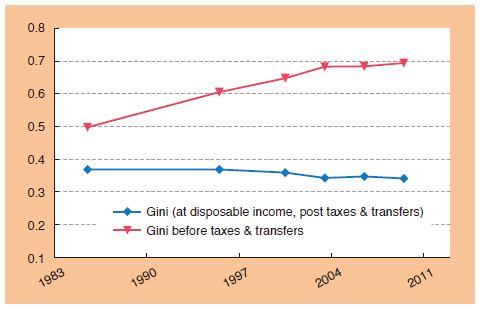
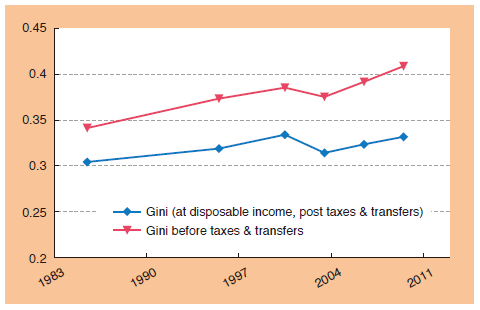
It is evident that fiscal redistribution significantly reduces income inequality for the elderly population. The Gini drops from close to 0.7 to close to 0.3 in most recent years as a result of redistribution, with the disposable income Gini even showing a slight downward trend. By contrast, inequality in disposable income for the working population—that is, mostly the wage inequality—shows a high correlation with market inequality. A simple bilateral regression suggests that, for the working-age population, each point increase in the market income Gini translates into a 0.4 point increase in the disposable income Gini.
This suggests that for working households variations in market income inequality are highly associated with variations in disposable income inequality, although fiscal redistribution brings down the level of inequality to some extent. In other words, the dynamics of market income inequality for the working-age populations correspond to the dynamics of disposable income inequality changes, which have a direct impact on their living standards.
The large gap between the market income and disposable income inequality for the elderly is a sign of fiscal burden. A report by the OECD, "An Overview of Growing Income Inequalities in OECD Countries: Main Findings" (2011), warns that reliance on the tax and transfer system as a major mechanism of equalization of income is not an efficient or sustainable strategy. In the same vein, a more recent country brief, "JAPAN: Advancing the third arrow for a resilient economy and inclusive growth" (Better Policies Series) points out that "population ageing will put pressure on public finances, which are already over-stretched." Although a discussion of feasible fiscal policy options is beyond the scope of this article, Japan might need to take into account the fiscal costs of redistribution, given its high and rising public debt, its increasing share of the elderly population, low fertility rate, and rising dependency ratio. In this regard, the Japanese government's emphasis on structural reforms, including labor market reforms, seems appropriate.
Other Dimensions of Inequality
The evidence presented so far suggests that income disparities are widening in Japan amongst the working-age population. The drivers of such disparities need to be studied more in detail, but there are at least two prominent dimensions over which income inequality—or primarily wage inequality for the working population—is observed: namely, the gender gap and labor market duality.
Labor participation rates, defined as the ratio of the labor force to the population aged above 16 years old, are declining in general due to Japan's aging population. Nevertheless, the Female Labor Participation (FLP) rate is lower than the Male Participation Rate (MPR) by about 20 percentage points.
Low labor force participation and underemployment of women imply a lack of inclusiveness in the process of growth, which cannot be fully captured by household-based poverty measures. As strongly emphasized by the IMF, low FLP is also costly in terms of reduced potential growth. The problem is compounded by the fact that the Japanese economy has been experiencing negative growth of labor input for years and facing labor shortages in more recent years.
Another important driver of inequality is labor market duality. According to data by the Ministry of Internal Affairs and Communications, the share of non-regular workers consistently increased from less than 20% in the 1980s to above 37% by 2015. In "The Path to Higher Growth: Does Revamping Japan's Dual Labor Market Matter?" (IMF Working Paper, WP/13/202, 2013), Chie Aoyagi and Giovanni Ganelli stress that such excessive labor market duality is likely to be holding back growth by reducing productivity. The two factors discussed here, low FLP and duality, are interrelated, since more than half of employed women are non-regular workers, with less job security, lower wages, and reduced career opportunities.
In summary, the evidence presented so far shows that inequality has increased in Japan in recent decades, and suggests that, with the bulk of fiscal redistribution benefitting the elderly, the economic burden of rising inequality and poverty is concentrated in a disproportionate way on women and non-regular workers. This observation is particularly relevant and important when growth of the economy on average is promoted without considering inclusiveness. Will growth generated by an implementation of Abenomics be equally shared or will it create more inequality? If the latter is true, will the increased inequality be compensated by average income growth, so that those who are left behind can still enjoy some of the prosperity that comes with the growth of the economy? What would be the inequality implications of successfully exiting deflation and of structural reforms in the labor market? A recent study, "How Inclusive is Abenomics?" (Aoyagi, Ganelli and Kentaro Murayama, Journal of International Commerce, Economics and Policy, Vol. 07, No. 01, 2016), seeks to address such issues in a systematic way by conducting an econometric analysis on the impact of key policy variables on a measure of inclusive growth. The study uses prefectural level longitudinal data from the National Population Census, which is conducted every five years, and includes information on various economic variables as well as on income distribution at the prefectural level.
As a measure of inclusive growth, the study uses the indicator developed by R. Anand, S. Mishra, and S. J. Peiris in "Inclusive Growth: Measurement and Determinants" (IMF Working Paper, WP/13/135, 2013). Intuitively, the latter is a weighted average of growth in average income and of the change in an equity index which takes into account income distribution. The equity index is built in a way that it is bounded between zero and one, with one being a perfectly equitable income distribution. This measure of inclusive growth is equivalent to average income growth in the hypothetical case of growth which leaves income distribution unchanged, but deviates upward (downward) from average income growth when growth is achieved by making income distribution more equal (unequal). In other words, our proxy can be interpreted as a measure of growth in average income "corrected" for the equity impact.
In Japan, the majority of growth episodes experienced deteriorating equality (i.e. negative equity index growth), but achieved "inclusive growth" by having sufficiently high average income growth. Cases in which both average income and equality increase are relatively rare. The 1994-1999 and 1999-2004 periods are characterized by both low average income growth and increasing inequality. Moreover, on average, high growth in the late 1980s and the early 1990s compensated for increasing inequality (i.e. the negative change in equity index), while the negative growth in the late 1990s and the early 2000s failed to keep inclusive growth positive.
Prefectural averages of growth rates over time confirm a relatively small impact of the equity index on this inclusiveness indicator, with a few exceptions. For Wakayama, Okayama, and Okinawa prefectures, average income growth is too low to compensate for the relatively high negative growth of the equity index, leading to near-zero inclusive growth.
In summary, it is evident that the major driver on average of inclusive growth in Japan is the growth in average income. One exception is the period between 1994 through 1999, where the income growth was so weak that the negative growth in equality outweighed it. For the 1980s through the early 1990s, the average income growth was at least four times stronger than the deteriorating equity index growth. For the years between 1999 and 2004, the negative growth was worsened by the negative growth in the equity index.
Empirical Strategy
Aoyagi, Ganelli, and Murayama (2016) regress their chosen measure of inclusive growth on various variables of interest, including: inflation; the ratios of part- to full-time job openings; female labor force participation; and labor input. These variables proxy the following key policy objectives of Abenomics, respectively: i) achieving positive inflation in a stable manner; ii) increasing flexibility in the labor market and reducing duality; iii) increasing the female labor participation rate; and iv) increasing overall labor input. In addition, control variables are included in the regression to account for the size of the prefectural economy (initial GDP per capita) and the degree of "aging" of each prefecture (elderly index, defined as the size of population 65 years old or older divided by the size of working-age population).
Results of the Empirical Analysis
The empirical results of Aoyagi, Ganelli and Murayama (2016) suggest that inflation has a positive and initially increasing, but then falling effect on inclusive growth. Furthermore, the inflation coefficients are significant for the overall inclusive growth measure and for the growth in average income. This means that moving towards the 2% inflation goals set by the Bank of Japan (BOJ) will promote growth. Labor market duality—measured by the ratio between the numbers of new offers for part-time and regular employment—has a negative and significant impact on inclusive growth through its negative impact on average income growth for the full sample and working-age sub-sample. A higher female participation rate has a positive effect on inclusive growth by increasing average income growth. Furthermore, this variable has positive and sizable effects both on average income and equity index growth, when using the working-age household sample. On the other hand, increasing overall labor input would boost inclusive growth by increasing both average income and equity (although only the effect on the former is significant). Those findings indicate the importance of labor market reform.
Scenario Analysis
Aoyagi, Ganelli, and Murayama (2016) also conducted some scenario analysis, based on their econometric results, of what would be the impact on inclusive growth of key policy objectives in the Abenomics package. The scenarios present the marginal effect of changes in each policy variable (Table). Values in each row are computed as the scenario changes in the variable times the marginal effects, while all other things held constant. The scenario analysis used the base level of inclusive growth at the national level during 2000-04, which is -1.46% for the entire household sample and -1.15% for the working-age household sample, as references to evaluate the magnitude of marginal effects.
As shown in the Table, the effect of getting the economy out of deflation is captured as a change in CPI inflation from 0.0% (its value in 2012 before the start of Abenomics) to the BOJ target of 2.0%. When the coefficient based on the full sample estimate is used, the impact is that annual inclusive growth would be 1.76 percentage points higher. This is a large boost to growth, especially considering that it counters more than the base growth level at the national level. An even stronger result emerges for the working-age household case, in which the relative magnitude of 1.91% is more than enough to raise the negative growth above zero. It should be noted that such gains mostly come from the increase in the growth of average income, while the equity index deteriorates (i.e. inequality grows) as inflation rises. Furthermore, the empirical estimation implies that inflation has an optimal level for the average income growth. Beyond or below this optimal level (around 2%; or 3% if using the working-age households sample estimation), the inflation rate shows a still positive (for a certain range) but diminished effect on average income growth. If inflation further increases, then the marginal effects will become negative eventually. With the initial value of 0.0% inflation, about 4.5% is the upper threshold for marginal gains in inclusive growth from higher inflation.
As a scenario for reducing labor market duality, the analysis considers the case in which the measure of duality used in the study goes back to its pre-bubble level of 5% (from 21% for the most recent available data). With such a shift in labor market duality, inclusive growth would be 0.45 percentage points higher. The impact of the change in terms of composition is qualitatively similar to one from inflation: the bulk of the boost to inclusive growth comes from increasing growth of the average income, while equality decreases slightly. In other words, labor market duality affects the productivity of the economy, rather than inequality at the aggregate level. An interpretation of this result is that a lower share of part-time workers, while increasing productivity, also increases inequality because it prevents some workers who can only work part-time from being employed.
Female labor participation rates (aged above 15 years old) historically hovered around 48%, while male labor participation was about 70%. The scenario analysis considers a case where the female labor participation increases by 5 percentage points, which is an ambitious but feasible goal. On the basis of the estimates from the full sample analysis, this would boost inclusive growth by 0.83 percentage points, about two-thirds of the base growth level. Similar to reducing labor market duality, the estimated impact is even larger when estimating with the working-age household sample. Inclusive growth is boosted by 1.13 percentage points, while both average growth and equity index growth are raised by 0.78 and 0.35 percentage points, respectively.
Labor input, measured by the man-hour, has been in decline since 1979, reaching negative growth at the national level since the 1990- 1994 period. The scenario analysis considers a rather conservative case in which reforms manage to shift the growth of labor input from negative to zero. In other words, our scenario assumes that the increase in the labor input just compensates for its natural decrease (i.e. population decline). In this case inclusive growth would be 0.42% higher than the latest level in the 2000-2004 period, mostly derived from the average income growth. The relative magnitude of marginal effect is about one-third of the level in 1999-2004, making it a little less effective than achieving the inflation target or addressing dual labor market duality.
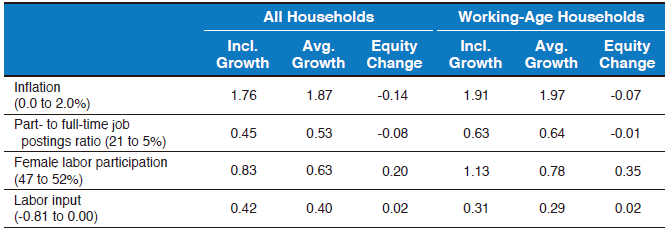
Conclusions & Policy Implications
This article has reviewed trends and econometric studies to assess the inclusiveness of Abenomics. One important policy implication of the empirical evidence we review is that the best way for Abenomics to foster inclusive growth, through both growth of average income and improvement in equity, is to fully implement structural reforms, i.e. to fully launch the third arrow.
The empirical research reviewed here suggests that while achieving the 2% inflation target is expected to stimulate average income growth, it will also have a negative impact on income equality.
On the other hand, structural reforms are estimated to contribute to both more robust growth and improved income equality. In particular, reducing labor market duality is expected to increase productivity and foster growth, with a small adverse effect on equality. The latter would be more than compensated for by the effects of other reforms, such as increased female labor participation and overall labor supply growth, which are found to be effective in promoting both average income growth and income equality.
Based on the findings by Aoyagi, Ganelli, and Murayama (2016), our assessment of the inclusiveness of Abenomics is that, if all the arrows are fully launched, this policy framework can be effective in promoting both growth and income equality, therefore fostering inclusive growth.
This article first appeared on the November/December 2016 issue of Japan SPOTLIGHT published by Japan Economic Foundation. Reproduced with permission.
November/December 2016 Japan SPOTLIGHT



